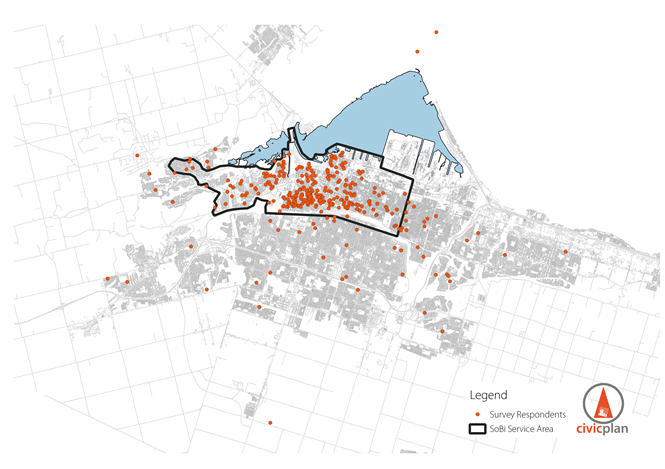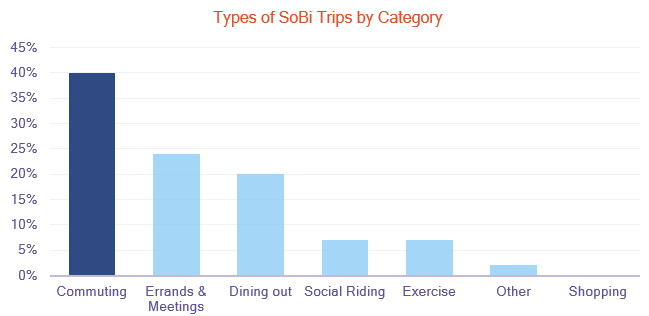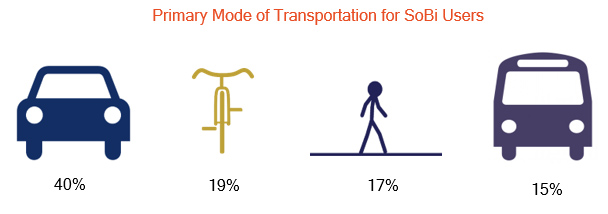Hamilton’s SoBi Delivers on Key Bike Share Promises: User Engagement Highlights
Why Bike Share?
Cities across North America from Atlanta to Vancouver have established bike share programs to address a variety of urban issues and policy objectives. Promoting cycling as a means of everyday transportation supports public health officials, city planners, environmental advocates and sustainably minded transportation planners. In general, bike share programs promise to encourage active transportation, relieve congestion by replacing short range automobile trips and thereby act to mitigate air pollution. Often bike share programs are said to reduce barriers to adopting cycling as a viable transportation option, provide efficient connections to and from transportation networks and be a lower cost transportation option.
Cycling and bike share programs are unlikely to be a salve for all public health and transportation woes, as it is a tall order for most cities where trips are made overwhelmingly by single occupant automobiles. In some way, the widespread adoption of bike share programs can be explained by cities looking to global best practices for innovative or sustainable planning solutions. Sustainability planning has emerged as a means of selling cities as ‘green’ and ‘livable’ in a globally competitive marketplace for investment and talent. However, the implementation of these ‘best practices’ can lead to a wide variety of outcomes based on the political, cultural, geographic and institutional contexts.
SoBi Hamilton
In 2015, the City of Hamilton launched its bike share program, Social Bicycles or SoBi. Presently, SoBi boasts over 10,000 members, 129 stations and 825 bikes positioned within a 20 square kilometer service area. Due to the unique geography of being a port city hemmed in by the formidable Niagara Escarpment, SoBi serves the relatively flat lower city. Some of the defining features of SoBi include bikes equipped with an integrated U-lock connected to a GPS-enabled on-board computer to track the bike’s location, and the ability to lock-up anywhere within the system catchment area, not just SoBi parking stations. Another member can find the locked bike, reserve it and return it to a station at the end of their trip to receive a credit on their account. SoBi offers its users a flexible, convenient, healthy and affordable transportation option.
In order to gain greater insights into its network, Civicplan assists SoBi in surveying it’s members to see how they make use of the bike share program. Conducted using the PlanLocal platform, 420 respondents participated and the results serve to illustrate how Hamilton’s bike share program are meeting its policy objectives.
Who Are SoBi Members?
The majority of respondents to the survey were over the age of 35 (57%), the largest single age category was respondents between 25-34 years of age (32%). In keeping with the demographic profile of most bike share platforms, 94 percent of respondents had at least some post-secondary education, the largest segment being at least 4 years of College or University (43%). Overall, there was a fairly even income distribution, with all categories over $40,000 in household income placing between 12 and 15 percent of respondents. The largest single household income segment of respondents (24%) was between $100,000 and $150,000.
How People Use SoBi
The survey asked about member’s primary use of SoBi. Commuting was the single largest category of SoBi trips (40%), followed by errands and meetings (24%), dining out (20%).
Respondents were asked to describe if and how they use SoBi to connect with transit.
Overall, close to 40 percent of respondents report that they connect with either GO transit, the regional transportation service provider, the local transportation system (Hamilton Street Railway), or both.
This reinforces the idea that bike share fills a distinct part of the larger transportation system, namely, they help provide efficient connections to and from transit networks, and increase time competitiveness of sustainable modes compared with personal motor vehicles. This is particularly valuable in parts of the city that may not be well served by public transportation.
Travel Behaviour
Respondents were asked to rate how their SoBi membership impacted their use of a variety of other modes of transportation, such as private automobile, transit, walking, among others. Respondents rated the impact of SoBi on their use of each mode along a scale ranging from much less often to much more often.
Overall, 49 percent of respondents noted they used an automobile less often or much less often since joining SoBi.
Other Highlights
- Driving a vehicle was the primary mode of transportation for the largest segment of respondents (40%), followed by cycling (19%), walking (17%) and public transit (15%).
- Respondents had a very high satisfaction rate with SoBi overall. 86 percent indicated they were either very satisfied (50%) or satisfied (36%).
- 49 percent of respondents indicated that their current membership type was a pay as you go (hourly) membership. This was followed by 29 percent of respondents indicating an annual membership.
- 24 percent of respondents indicated that they use SoBi for running errands or travelling to meetings, and 20 percent for dining out. This behavior seems to align with studies that show how the success of bike share programs is positively correlated to residential and employment density as well as density of food service providers.




